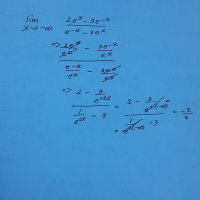You are using an out of date browser. It may not display this or other websites correctly.
You should upgrade or use an alternative browser.
You should upgrade or use an alternative browser.
Why does the answer I get is always -2/3 when the solution says its -3
- Thread starter ttete946
- Start date
- Joined
- Feb 4, 2004
- Messages
- 16,582
You're thinking in terms of [imath]x[/imath] trending toward *positive* infinity. But the limit is for *negative* infinity.
When you're on the negative side of the [imath]x[/imath]-axis, [imath]e^{2x}[/imath] is going to get very small, because the [imath]2[/imath] is positive and the [imath]x[/imath] is getting strongly negative, so the base is being raised to a negative power. So it is actually the [imath]e^x[/imath] terms that are disappearing, leaving you with [imath]\frac{-3}{1}[/imath].
When you're on the negative side of the [imath]x[/imath]-axis, [imath]e^{2x}[/imath] is going to get very small, because the [imath]2[/imath] is positive and the [imath]x[/imath] is getting strongly negative, so the base is being raised to a negative power. So it is actually the [imath]e^x[/imath] terms that are disappearing, leaving you with [imath]\frac{-3}{1}[/imath].
Steven G
Elite Member
- Joined
- Dec 30, 2014
- Messages
- 14,561
\(\displaystyle \dfrac {1}{e^{-\infty}}\) tends to infinity, NOT 0.
I always like to change these type of problems from x goes to -infinty to x goes to +infinity AND change all x's to -x[/tex]
Also, there is no need to trust 'solution' as it may be wrong.
All you need is to replace x with say -10,000 and see if that result is close to -2/3, -3 or something else.
I always like to change these type of problems from x goes to -infinty to x goes to +infinity AND change all x's to -x[/tex]
Also, there is no need to trust 'solution' as it may be wrong.
All you need is to replace x with say -10,000 and see if that result is close to -2/3, -3 or something else.
Thanks so much that's a very nice way to approach it!\(\displaystyle \dfrac {1}{e^{-\infty}}\) tends to infinity, NOT 0.
I always like to change these type of problems from x goes to -infinty to x goes to +infinity AND change all x's to -x[/tex]
Also, there is no need to trust 'solution' as it may be wrong.
All you need is to replace x with say -10,000 and see if that result is close to -2/3, -3 or something else.
Thank you. I guess I need to be careful about weather it's negative or positive cuz it's a totally different questions eachYou're thinking in terms of [imath]x[/imath] trending toward *positive* infinity. But the limit is for *negative* infinity.
When you're on the negative side of the [imath]x[/imath]-axis, [imath]e^{2x}[/imath] is going to get very small, because the [imath]2[/imath] is positive and the [imath]x[/imath] is getting strongly negative, so the base is being raised to a negative power. So it is actually the [imath]e^x[/imath] terms that are disappearing, leaving you with [imath]\frac{-3}{1}[/imath].
- Joined
- Feb 4, 2004
- Messages
- 16,582
I guess I need to be careful about weather it's negative or positive cuz it's a totally different questions each
It's not that it's a totally different question. It's that we're used to thinking in terms of positive infinity, and we forget that, just because there is no "minus" sign on the exponent, doesn't mean that it isn't negative. It's a human failing.
But yes, you *will* need to be careful because, as you've now seen, negativity can work in ways that we forget to think of. And, since you've had a question like this in your homework, you can safely expect to see this on your next test. Yes, we math teachers often enjoy being tricky like this.

